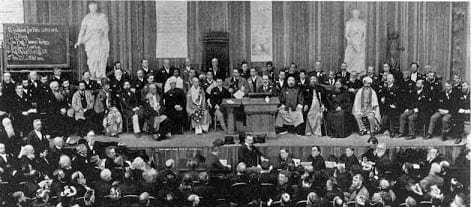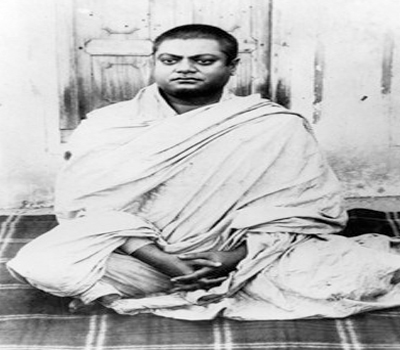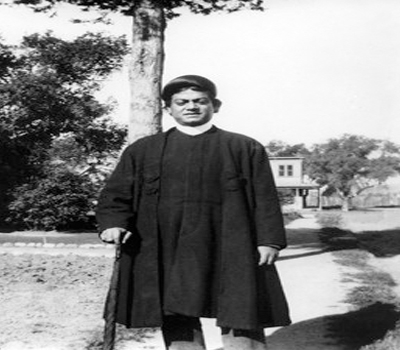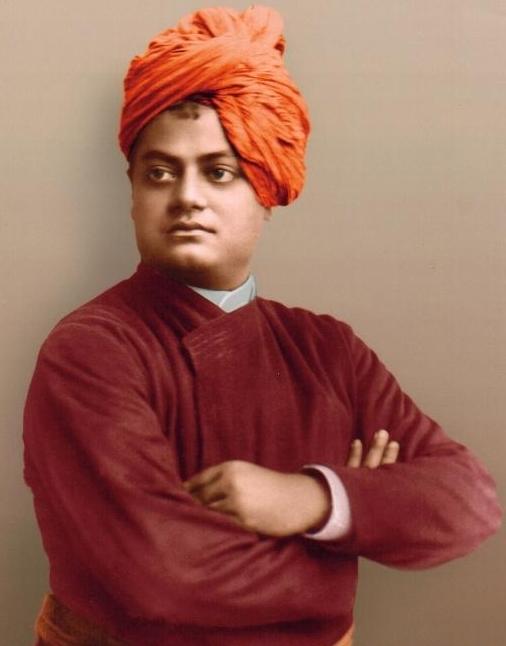AN EXTERNAL IMAGE EVOKES a corresponding mood in the perceiver’s mind. One sublime image that has evoked veneration, joy, courage, peace, and introspection for thousands of years is that of Buddha. It is natural for people to build monuments to remember his achievements, and we find scores of them all over the world. As humanity progresses, it understands that its greatest achievement is the supremely meditative face of Buddha. Buddha is not just a god, statue, or a picture; it is a state of consciousness. His personality, life, and teachings helped peacefully spread noble ideas to the whole of Asia, changing it culturally and spiritually. He is today one of the most recognizable and revered icons of humanity. Two thousand fi ve hundred years aft er Buddha’s birth, the ancient warrior races and nations are slowly replacing their old icons of muscular heroes wielding weapons with sublime meditation figures.
Many people noticed that Swami Vivekananda resembled Buddha. Sir Jamsetji Tata, the founder of an industrial and commercial conglomerate ‘once told Sister Nivedita: when the Swami was in Japan, everyone who saw him was struck by his likeness to Buddha.’1 The London Daily Chronicle wrote: ‘Vivekananda, the popular Hindu monk, whose physiognomy bore the most striking resemblance to the classic face of Buddha, denounced our commercial prosperity, our bloody wars, and our religious intolerance, declaring that at such a price the mild Hindu would have none of our vaunted civilization’ (2.46). Swamiji’s resemblance to Buddha was more pronounced while meditating and also in his well-known meditation picture. It was Swamiji who brought yoga and meditation to the West. He once declared:
‘I have a message to the West as Buddha had a message to the East.’2 Today, due to globalization, there are many common areas of interest and interaction between different people and nations, but meditation and yoga are spreading like wildfire. The sublime feeling of timelessness, seen in the faces of these Master yogis, makes us yearn to experience what they did.
The Characteristic of the Age
Humankind has advanced more rapidly through art, music, literature, travel, exploration, science, and philosophy than through wars, diplomacy, cunning, and crime. Over thousands of years we have been continuously redesigning and reinventing ourselves to survive nature’s challenges. The capacity to do this has been principally of the mind. Today, with the various crises facing humanity—one of which is global climate change—meditation and yoga offer a truly remarkable solution for reinventing ourselves for global peace and progress. Human intelligence and ingenuity have advanced to a point where we are no longer pushed by nature but participate with her to reap tremendous benefits. Meditation and yoga also protect us from misusing these benefits, making them available to all people. The mind accelerates our spiritual evolution so that we can finally become living gods.
It is obvious that humanity has understood the importance of mental health over physical well-being and social progress. It has also understood that pugnacity and violence have no place in human progress, and that the future will be defined by peace, cooperation, and interaction. The future will thus see the dominance of mind over matter.
This age can be called the age of the mind, for we are discovering many of its secrets, dimensions, and powers. There was a time when nature, and we, designed huge bodies with brawn in order to survive those violent times. As the need for huge bodies is diminishing, nature is compensating us with remarkable minds. The explosion of knowledge everywhere is one of the results of this mental development.
The body and the brain are malleable and can be transformed. Thoughts, learning, and culture sculpt the brain. The most powerful sculptors of the brain and mind are meditation and yoga. They can quickly and permanently alter the body and brain in a healthy way and make it ready it for higher consciousness to manifest. A healthy brain altered by meditation also influences others through peace, love, and joy. Such brains and minds change society for the better. As humankind is entering vast mental realms, contemplative people will predominate over busy people. We have already begun to use our thoughts to cure phobias, quicken the body’s curative powers, and do a host of other things. We can move paralysed limbs, make the brain perceive even without the senses—aided with sophisticated machines and computers—and do a lot of things that border on science fiction.
The New Wave
There is a kind of collective neurosis affecting people all over the world. This neurosis is reflected in literature, art, music, cinema, relationships, and so on. As society becomes more developed, so is life getting more restless and more disengaged with reality. The mind has become disintegrated and directionless. Society and life in the past seem to have been more ordered. Is the mind, spoken so highly of, ready for meditation and yoga? It looks unlikely. No doubt this neurosis is a sign of something going wrong at the basic level of the human psyche, but this is what is pushing us on to meditation and yoga. The proliferation of these means has come at a crucial time in human history. Otherwise, equipped with enormous mental power and achievements, humanity might implode and destroy itself. Meditation and yoga have the capacity to channel these mental forces and take us to the next level of development. One is tempted here to assume that the Divine—working through Sri Ramakrishna, the Holy Mother, and Swamiji—had kept ready the antidote in advance in order to cure individual and social ills.
The active West, characterized as courageous and powerful, has taken up meditation and yoga in its usual proactive way, and that is why yoga is all the rage in the Americas and Europe. Many pundits, who assumed that this was another passing fad, have been proven wrong. Any real cultural shift takes a very long time to crystallize, and the present shift has taken fifty to hundred years. This shift should not be seen as the cultural influence of the contemplative East on the active West, but as humanity trying to find its equilibrium. There is a cultural shift even in the East that is harmonizing activity with contemplation. This is what Buddha and Swamiji preached.
The contemplative philosophies and the meditative practices of the East were long derided as lazy and morbid. It was ‘doing’ that people wanted and considered progressive. It was dynamic activity that showed how humankind ascends to higher levels of civilization. What constitutes ‘development’ was not clear, yet many people believed that meditation and all such things would arrest that ascent. Today there is an increase in the right understanding of contemplative practices and principles thanks to Swamiji, who toured extensively and preached the correct science of yoga. Too much ‘doing’ without meditation has taken individual life on a retrograde trajectory. ‘Development’ exploited the weak and destroyed nations, and when it started destroying the ‘doers’, then it dawned that there is something wrong with this attitude. This disengagement from excessive doing needed the support of ‘being’, and that is meditation and yoga.
For the last fifty years or more yogis and preachers from the East have found a ready field for teaching contemplation in the West. The harvest was bountiful. There has also been a flow of people from the West to the East who came for spirituality and carried it back home and preached it successfully. Not only did the West see cultural changes but there was a great revival of meditation and yoga in the East as well. All types of gurus and preachers in India successfully taught simple asanas and meditation, which attracted people in droves. People all over the world were caught up in a wave of yoga. Initially, for many it was yoga for health and fitness, but now people are approaching its core: spirituality. The need for spirituality is another factor that is helping the yoga wave.
There is a big distinction between religion and spirituality, beliefs and practices, and yoga is bridging this divide.
Renewal of an Ancient Science
When Swamiji went to the West the words ‘yoga’ and ‘yogi’ were associated with queer ideas of powers, miracles, physical contortions, lying on a bed of nails, being immune to the extremes of heat, cold, pain, and so on, and even levitation. The famous Indian rope-trick was associated with yogis with supernatural powers. Alexander the Great, after his invasion of India, encountered yoga and became impressed after meeting some yogis. However many misconceptions remained, even in India and the rest of the East. People wanted cures, know their future, avert some bad luck, and become prosperous. Yogic practices thus attracted the insincere and the fraudulent. Some yogis with slight powers hoodwinked the gullible. Sri Krishna had come earlier and revived to its pristine form the ancient yoga, which had become corrupted due to a long lapse of time.3 So also in this age Sri Ramakrishna, through Swamiji, revived yoga’s correct scientifi c principles and practices. Yoga and meditation were now unyoked from all dross and superstitions to be used for the good of humanity. They showed that each person was potentially a yogi or yogini.
Swamiji made yoga rational and harmonized its teachings with the latest knowledge of physiology, psychology, and science. By bringing in the schools of Vedanta and Tantra he made yoga comprehensive. Besides, he also brought in the elements of karma, jnana, and bhakti into its methodology. Thus, all the ancient and modern streams of knowledge and practices were fused into making the ancient yoga philosophy ideal for modern humans. He removed all mystery, secrecy, and rites surrounding yoga and preached it rationally. No longer was there a need for a cave, forest, temple, or any isolated place. Meditation and yoga could be done at home, at work, at any time and place, and by any person.
This is the second time that the ancient practices of yoga were harmonized for the good of the world. Yoga and meditation have a very long history in India. Different yogis experimented with the mind differently and came up with new methods, but these were kept secret in their respective sects. Patanjali, the great yogi, strung together some of the authentic practices systematically and formed the classic Yoga Sutra. In this age the great yogi Swamiji, though born a dhyanasiddha, perfect in meditation, learnt from Sri Ramakrishna about many high states of yoga and preached it to the world.
There is an unprecedented explosion of knowledge. No one person can be an expert in all fields and no person can be an expert in one particular field. One branch of knowledge, for instance medicine, has split into thousands of branches, and besides doctors, other professionals like engineers, chemists, biologists, and so on are active in the field of medicine. Such multidisciplinary phenomenon is found in all areas. As knowledge progresses in a particular line, aft er a few years, it splits into numerous branches. Experts get into each branch and this again splits into more branches and so on. However, all knowledge is interconnected and it has expanded the human mind. All knowledge is internal and is drawing minds towards its core—that is consciousness.
Internalization has become a byword everywhere. It is not just unconscious assimilation or making attitudes and behaviour part of one’s nature, but internalizing all objects. Yoga teaches that there is one substance of varying density in the universe. Consciousness, concepts, words, and objects are different phases of that single substance. Internalization has made humans gravitate more towards the mental than the objective world. This orientation is also one of the reasons why yoga is necessary.
In the past the study of consciousness was strictly the domain of religion. It was called the soul. The conceptions of consciousness became better with the philosophers and with the psychologists who followed them. Now it is science and all related fields that are trying to understand consciousness. All knowledge can be said to be trying to discover consciousness. Yoga had since long cracked the problem of consciousness and showed it to be the core of the individual and of the universe. However, there are various levels of consciousness, and one needs to travel to its highest point in nirvikalpa samadhi. This is where yoga psychology and philosophy become useful in better
understanding human knowledge, the individual, and the universe.
Humanity in the Future
If we were to imagine the face of a future humanity, we would visualize it as meditative like that of Buddha, Sri Ramakrishna, and Swamiji. All science fiction conceptions of space travel and aliens are based on the old cultural ideology of conquest and dominion. This was what nations did in the past. All ideas of external conquests will be history as the old paradigms are replaced by the paradigm of meditation and yoga. The greatest conquest is the conquest of the mind. As we become experts in this age of the mind, humanity will mature quickly. Physically, we know that materials found in the whole universe are also present in us. Mentally, we know we are connected to all minds, for life is not individual but cosmic. The conquest of ourselves gives us the power over the whole of nature; not the old type of power but the power of love, for that is the essence of consciousness. Yoga will thus be the key to unlock the real nature of humanity and the world. There is no need for laser guns and spaceships, but there is a need for meditation.
The future face is the face of Buddha, of Sri Ramakrishna, and of Swamiji. The three are not separate. When young, Swamiji was one day still sitting on his asana after meditation at his home when he had the vision of Buddha. ‘I saw the extraordinary figure of a monk appear suddenly … and stand before me at a little distance filling the room with a divine effulgence. He was in ochre cloth with a Kamandalu in his hand. His face bore such a calm and serene expression of inwardness born of indifference to all things that I was amazed and felt much drawn towards him. He walked forward towards me with a slow step with his eyes steadfastly fixed on me, as if he wanted to say something.’4 Thus began Swamiji’s lifelong association and attraction for Buddha. Another powerful factor that contributed to Swamiji’s ‘veneration for Buddha was, to quote Sister Nivedita’s words, “the spectacle of the constant tallying of his own Master’s life, lived before his eyes, with this world-attested story of twenty-five centuries before. In Buddha he saw Ramakrishna Paramahamsa: in Ramakrishna he saw Buddha”.’5
The beauty and sublimity of Sri Ramakrishna’s famous meditation picture is evident. This will be the future object of worship through meditation and yoga. Sri Sarada Devi the Holy Mother once revealed: ‘One day the Master came there [Nahabat] and at the sight of the [his] picture he said “Hallo, what is all this?” … Then I saw the Master take in his hand the Bel leaves and flowers kept there for worship, and offer them to the photograph.’ 6 Sri Ramakrishna, on looking at his picture remarked: ‘This represents a high yogic state. This form will be worshipped in every home as time goes on.’⁷
(Source: Prabuddha Bharatha January 2013)
References
1. His Eastern and Western Disciples, The Life of Swami Vivekananda, 2 vols (Kolkata: Advaita Ashrama, 2008), 2.398.
2.Th e Complete Works of Swami Vivekananda, 9 vols (Calcutta: Advaita Ashrama, 1–8, 1989; 9, 1997), 5.314.
3. Bhagavadgita, 4.1–2.
4. Swami Saradananda, Sri Ramakrishna the Great Master, trans. Swami Jagadananda (Chennai: Ramakrishna Math, 2010), 1134–5.
5. The Life of Swami Vivekananda, 2.545.
6. Her Devotee-Children, The Gospel of the Holy Mother (Chennai: Ramakrishna Math, 2012), 96.
7. Swami Chetanananda, Ramakrishna as We Saw Him (Kolkata: Advaita Ashrama, 2008), 468.







Leave A Comment